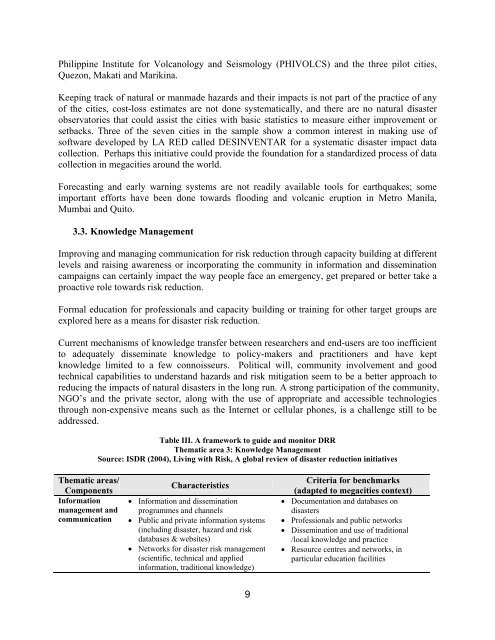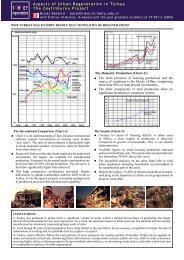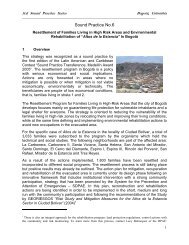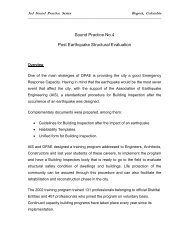A comparative analysis of Disaster Risk management Practices in ...
A comparative analysis of Disaster Risk management Practices in ...
A comparative analysis of Disaster Risk management Practices in ...
You also want an ePaper? Increase the reach of your titles
YUMPU automatically turns print PDFs into web optimized ePapers that Google loves.
Philipp<strong>in</strong>e Institute for Volcanology and Seismology (PHIVOLCS) and the three pilot cities,Quezon, Makati and Marik<strong>in</strong>a.Keep<strong>in</strong>g track <strong>of</strong> natural or manmade hazards and their impacts is not part <strong>of</strong> the practice <strong>of</strong> any<strong>of</strong> the cities, cost-loss estimates are not done systematically, and there are no natural disasterobservatories that could assist the cities with basic statistics to measure either improvement orsetbacks. Three <strong>of</strong> the seven cities <strong>in</strong> the sample show a common <strong>in</strong>terest <strong>in</strong> mak<strong>in</strong>g use <strong>of</strong>s<strong>of</strong>tware developed by LA RED called DESINVENTAR for a systematic disaster impact datacollection. Perhaps this <strong>in</strong>itiative could provide the foundation for a standardized process <strong>of</strong> datacollection <strong>in</strong> megacities around the world.Forecast<strong>in</strong>g and early warn<strong>in</strong>g systems are not readily available tools for earthquakes; someimportant efforts have been done towards flood<strong>in</strong>g and volcanic eruption <strong>in</strong> Metro Manila,Mumbai and Quito.3.3. Knowledge ManagementImprov<strong>in</strong>g and manag<strong>in</strong>g communication for risk reduction through capacity build<strong>in</strong>g at differentlevels and rais<strong>in</strong>g awareness or <strong>in</strong>corporat<strong>in</strong>g the community <strong>in</strong> <strong>in</strong>formation and dissem<strong>in</strong>ationcampaigns can certa<strong>in</strong>ly impact the way people face an emergency, get prepared or better take aproactive role towards risk reduction.Formal education for pr<strong>of</strong>essionals and capacity build<strong>in</strong>g or tra<strong>in</strong><strong>in</strong>g for other target groups areexplored here as a means for disaster risk reduction.Current mechanisms <strong>of</strong> knowledge transfer between researchers and end-users are too <strong>in</strong>efficientto adequately dissem<strong>in</strong>ate knowledge to policy-makers and practitioners and have keptknowledge limited to a few connoisseurs. Political will, community <strong>in</strong>volvement and goodtechnical capabilities to understand hazards and risk mitigation seem to be a better approach toreduc<strong>in</strong>g the impacts <strong>of</strong> natural disasters <strong>in</strong> the long run. A strong participation <strong>of</strong> the community,NGO’s and the private sector, along with the use <strong>of</strong> appropriate and accessible technologiesthrough non-expensive means such as the Internet or cellular phones, is a challenge still to beaddressed.Table III. A framework to guide and monitor DRRThematic area 3: Knowledge ManagementSource: ISDR (2004), Liv<strong>in</strong>g with <strong>Risk</strong>, A global review <strong>of</strong> disaster reduction <strong>in</strong>itiativesThematic areas/ComponentsInformation<strong>management</strong> andcommunicationCharacteristics• Information and dissem<strong>in</strong>ationprogrammes and channels• Public and private <strong>in</strong>formation systems(<strong>in</strong>clud<strong>in</strong>g disaster, hazard and riskdatabases & websites)• Networks for disaster risk <strong>management</strong>(scientific, technical and applied<strong>in</strong>formation, traditional knowledge)Criteria for benchmarks(adapted to megacities context)• Documentation and databases ondisasters• Pr<strong>of</strong>essionals and public networks• Dissem<strong>in</strong>ation and use <strong>of</strong> traditional/local knowledge and practice• Resource centres and networks, <strong>in</strong>particular education facilities9







